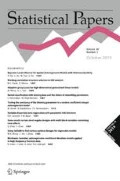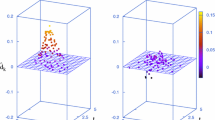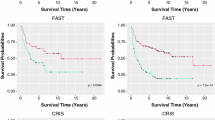Abstract
With the explosion of ultrahigh dimensional data in various fields, many sure independent screening methods have been proposed to reduce the dimensionality of data from a large scale to a relatively moderate scale. For censored survival data, the existing screening methods mainly adopt the Kaplan–Meier estimator to handle censoring, which may not perform well for heavy censoring cases. In this article, we propose a novel sure independent screening procedure based on distance correlation after standardizing marginal variables for ultrahigh dimensional survival data. It is a model-free approach and does not involve the Kaplan–Meier estimator, thus its performance is much more robust than the existing methods. Furthermore, our proposed method enjoys other advantages: it avoids the complication to specify an actual model from large number of covariates; it enjoys the sure screening property and the ranking consistency under some mild regularity conditions; it does not require any complicated numerical optimization, so the corresponding calculation is very simple and fast. Extensive numerical studies demonstrate that the proposed method has favorable exhibition over the existing methods. As an illustration, we apply the proposed method to a gene expression data set.








Similar content being viewed by others
References
Candes E, Tao T (2007) The Dantzig selector: statistical estimation when \(p\) is much larger than \(n\). Ann Stat 35:2313–2351
Chang J, Tang CY, Wu Y (2013) Marginal empirical likelihood and sure independence feature screening. Ann Stat 41:2123–2148
Chen XL, Chen XJ, Liu Y (2019) A note on quantile feature screening via distance correlation. Stat Pap 60:1741–1762
Chu Y, Lin L (2018) Conditional SIRS for nonparametric and semiparametric models by marginal empirical likelihood. Stat Pap. https://doi.org/10.1007/s00362-018-0993-1
Cui H, Li R, Zhong W (2015) Model-free feature screening for ultrahigh dimensional discriminant analysis. J Am Stat Assoc 110:630–641
Fan J, Li R (2001) Variable selection via nonconcave penalized likelihood and its oracle properties. J Am Stat Assoc 96:1348–1360
Fan J, Lv J (2008) Sure independence screening for ultrahigh dimensional feature space. J R Stat Soc B 70:849–911
Fan J, Song R (2010) Sure independence screening in generalized linear models with NP-dimensionality. Ann Stat 38:3567–3604
Fan J, Samworth R, Wu Y (2009) Ultrahigh dimensional feature selection: beyond the linear model. J Mach Learn Res 10:2013–2038
Fan J, Feng Y, Wu Y (2010) High-dimensional variable selection for Cox’s proportional hazards model. Borrowing strength: theory powering applications: a Festschrift for Lawrence D. Brown. Institute of Mathematical Statistics, Beachwood
Fan J, Feng Y, Song R (2011) Nonparametric independence screening in sparse ultra-high-dimensional additive models. J Am Stat Assoc 106:544–557
Fan J, Ma Y, Dai W (2014) Nonparametric independence screening in sparse ultra-high-dimensional varying coefficient models. J Am Stat Assoc 109:1270–1284
Gorst-Rasmussen A, Scheike T (2013) Independent screening for single-index hazard rate models with ultrahigh dimensional features. J R Stat Soc B 75:217–245
He X, Wang L, Hong HG (2013) Quantile-adaptive model-free variable screening for high-dimensional heterogeneous data. Ann Stat 41:342–369
Hu Q, Lin L (2017) Conditional sure independence screening by conditional marginal empirical likelihood. Ann Inst Stat Math 69:63–96
Li H, Luan Y (2005) Boosting proportional hazards models using smoothing splines, with applications to high-dimensional microarray data. Bioinformatics 21:2403–2409
Li G, Peng H, Zhang J, Zhu L (2012a) Robust rank correlation based screening. Ann Stat 40:1846–1877
Li R, Zhong W, Zhu L (2012b) Feature screening via distance correlation learning. J Am Stat Assoc 107:1129–1139
Li J, Zheng Q, Peng L, Huang Z (2016) Survival impact index and ultrahigh-dimensional model-free screening with survival outcomes. Biometrics 72:1145–1154
Lin Y, Liu X, Hao M (2018) Model-free feature screening for high-dimensional survival data. Sci China Math 61:1617–1636
Liu Y, Wang Q (2018) Model-free feature screening for ultrahigh-dimensional data conditional on some variables. Ann Inst Stat Math 70:283–301
Liu J, Li R, Wu R (2014) Feature selection for varying coefficient models with ultrahigh-dimensional covariates. J Am Stat Assoc 109:266–274
Lu J, Lin L (2020) Model-free conditional screening via conditional distance correlation. Stat Pap 61:225–244
Mai Q, Zou H (2015) The fused Kolmogorov filter: a nonparametric model-free screening method. Ann Stat 43:1471–1497
Pan W, Wang X, Xiao W, Zhu H (2019) A generic sure independence screening procedure. J Am Stat Assoc 114:928–937
Rosenwald A, Wright G, Chan WC, Connors JM, Hermelink HK, Smeland EB, Staudt LM (2002) The use of molecular profiling to predict survival after chemotherapy for diffuse large-B-cell lymphoma. N Engl J Med 346:1937–1947
Song R, Lu W, Ma S, Jeng XJ (2014) Censored rank independence screening for high-dimensional survival data. Biometrika 101:799–814
Székely GJ, Rizzo ML, Bakirov NK (2007) Measuring and testing dependence by correlation of distances. Ann Stat 35:2769–2794
Tibshirani R (1996) Regression shrinkage and selection via the lasso. J R Stat Soc B 58:267–288
Tibshirani R (2009) Univariate shrinkage in the Cox model for high dimensional data. Stat Appl Genet Mol 8:1–18
Wu Y, Yin G (2015) Conditional quantile screening in ultrahigh-dimensional heterogeneous data. Biometrika 102:65–76
Xia X, Li J (2019) Copula-based partial correlation screening: a joint and robust approach. Stat Sin. https://doi.org/10.5705/ss.202018.0219
Xia X, Yang H, Li J (2016) Feature screening for generalized varying coefficient models with application to dichotomous responses. Comput Stat Data Anal 102:85–97
Xia X, Li J, Fu B (2019) Conditional quantile correlation learning for ultrahigh dimensional varying coefficient models and its application in survival analysis. Stat Sin 29:645–669
Yue M, Li J (2017) Improvement screening for ultra-high dimensional data with censored survival outcomes and varying coefficients. Int J Biostat 13:1–16
Zhang CH (2010) Nearly unbiased variable selection under minimax concave penalty. Ann Stat 38:894–942
Zhang J, Yin G, Liu Y, Wu Y (2018) Censored cumulative residual independent screening for ultrahigh-dimensional survival data. Lifetime Data Anal 24:273–292
Zhao SD, Li Y (2012) Principled sure independence screening for Cox models with ultra-high-dimensional covariates. J Mult Anal 105:397–411
Zhou T, Zhu L (2017) Model-free feature screening for ultrahigh dimensional censored regression. Stat Comput 27:947–961
Zhu LP, Li L, Li R, Zhu LX (2011) Model-free feature screening for ultrahigh-dimensional data. J Am Stat Assoc 106:1464–1475
Acknowledgements
This work is partly supported by the National Natural Science Foundation of China (Grants No. 12031016, 11971324, 11971362, 11771366, 11901581), Foundation of Science and Technology Innovation Service Capacity Building, Interdisciplinary Construction of Bioinformatics and Statistics, and Academy for Multidisciplinary Studies, Capital Normal University.
Author information
Authors and Affiliations
Corresponding author
Ethics declarations
Conflict of interest
The authors declare that they have no conflict of interest.
Additional information
Publisher's Note
Springer Nature remains neutral with regard to jurisdictional claims in published maps and institutional affiliations.
Appendix: Theoretical proofs
Appendix: Theoretical proofs
Proof of Theorem 1
To prove Theorem 1, we need to prove the uniform consistency of the denominator and the numerator of \(\widehat{\omega }_k\) respectively. Because the denominator of \(\widehat{\omega }_k\) has a similar form as the numerator, we only deal with its numerator \(\widehat{\mathrm{dcov}}^2(Z_k,Y)\) below.
It follows from the definitions of distance covariance and sample distance covariance that
where \(S_{k1} =\mathrm{E}(\Vert Z_k-\widetilde{Z}_k\Vert _1\Vert Y-\widetilde{Y}\Vert _2)\), \(S_{k2} =\mathrm{E}(\Vert Z_k-\widetilde{Z}_k\Vert _1)\mathrm{E}(\Vert Y-\widetilde{Y}\Vert _2)\), \(S_{k3}=\mathrm{E}\{ \mathrm{E}(\Vert Z_k-\widetilde{Z}_k\Vert _1|Z_k)\mathrm{E}(\Vert Y-\widetilde{Y}\Vert _2|Y)\}\), \(\widehat{S}_{k1}=\frac{1}{n^2}\sum \nolimits _{i=1}^n\sum \nolimits _{j=1}^n|Z_{ki}-Z_{kj}|\Vert \widehat{Y}_i-\widehat{Y}_j\Vert _2\), \(\widehat{S}_{k2}=\frac{1}{n^2}\sum \nolimits _{i=1}^n\sum \nolimits _{j=1}^n|Z_{ki}-Z_{kj}| \cdot \frac{1}{n^2}\sum \nolimits _{i=1}^n\sum \nolimits _{j=1}^n\Vert \widehat{Y}_i-\widehat{Y}_j\Vert _2\), \(\widehat{S}_{k3} =\frac{1}{n^3}\sum \nolimits _{i=1}^n\sum \nolimits _{j=1}^n\sum \nolimits _{l=1}^n|Z_{ki}-Z_{kl}|\Vert \widehat{Y}_j-\widehat{Y}_l\Vert _2\), \((\widetilde{Z}_k,\widetilde{Y})\) is an independent copy of \(({Z_k},{Y})\). Similarly, we define
where \(\widetilde{S}_{k1}\), \(\widetilde{S}_{k2}\) and \(\widetilde{S}_{k3}\) are obtained by replacing \(\widehat{Y}_i\) \((i=1,\ldots ,n)\) in \(\widehat{S}_{k1}\), \(\widehat{S}_{k2}\) and \(\widehat{S}_{k3}\) with \({Y}_i\) \((i=1,\ldots ,n)\) respectively. Specifically, \(\widetilde{S}_{k1}=1/{n^2}\sum _{i=1}^n\sum _{j=1}^n|Z_{ki}-Z_{kj}|\Vert Y_i-Y_j\Vert _2\), \(\widetilde{S}_{k2}=1/{n^2}\sum _{i=1}^n\sum _{j=1}^n|Z_{ki}-Z_{kj}|\cdot 1/{n^2}\sum _{i=1}^n\sum _{j=1}^n\Vert Y_i-Y_j\Vert _2\), \(\widetilde{S}_{k3}=1/{n^3}\sum _{i=1}^n\sum _{j=1}^n\sum _{l=1}^n|Z_{ki}-Z_{kl}|\Vert Y_j-Y_l\Vert _2\). Under the discussion in Li et al. (2012b), for any \(\epsilon >0\) and \(0<\gamma <1/2-\kappa \), there exist positive constants \(C_1\) and \(C_2\) such that
In order to obtain the exponential tail probability bound of \(P(|\mathrm{dcov}^2(Z_k,Y)-\widehat{\mathrm{dcov}}^2(Z_k,Y)|\ge \epsilon )\), we only need to compute \(P(|\widehat{\mathrm{dcov}}^2(Z_k,Y)-\widetilde{\mathrm{dcov}}^2(Z_k,Y)|\ge \epsilon )\). By the definition of \(\widehat{\mathrm{dcov}}^2(Z_k,Y)\) and \(\widetilde{\mathrm{dcov}}^2(Z_k,Y)\), we have
We first deal with \(|\widehat{S}_{k1}-\widetilde{S}_{k1}|\), straightforward calculations entail that
where
and the last inequality obtained by using the triangle inequality. As we all know, for any events \(H_1\) and \(H_2\), it holds
Define events \(A_i=\{|Z_{ki}|< n^{\gamma }\}\) \((i=1,\ldots ,n)\), by (6), condition C1, Bonferroni’s inequality and Markov’s inequality, we obtain
where \(C_3\) is a positive constant. Straightforward calculations entail that
We first consider \(I_1\), defining events \(B=\{|\widehat{\sigma }_1-{\sigma }_1|\le \sigma _1/2\}\) and \(C=\{|n^{-1}\sum _{i=1}^nX_i-{\mu }_1|\le \mu _1/2\}\), there exist some positive constants \(C_4\) and \(C_5\) such that
for positive constant \(C_4\). Since
\(I_3\) can be deduced as
where \(C_5\), \(C_6\) and \(C_7\) are some positive constants. Furthermore, there exists positive constant \(C_8\) such that
Combining (9), (10) and (11), we obtain
for positive constant \(C_{9}\). Using the similar arguments, there exists positive constant \(C_{10}\) such that
Following (7), (8), (12) and (13), we have
Using the analogous arguments, along with some tedious calculation, we can obtain similar conclusion of \(P\left( |\widehat{S}_{k2}-\widetilde{S}_{k2}|\ge \epsilon \right) \) and \(P\left( |\widehat{S}_{k3}-\widetilde{S}_{k3}|\ge \epsilon \right) \). Hence, we conclude that
for positive constant \(C_{12}\). Let \(\epsilon =cn^{-\kappa }\), where \(\kappa \) satisfies \(0<\kappa +\gamma <1/2\). Immediately, there exist some positive constants \(c_1\) and \(c_2\) such that
The convergence rate of the numerator of \(\widehat{\omega }_k\) is now achieved. Following similar arguments, we can obtain the same convergence rate of the denominator. Then we have
The first part of Theorem 1 is proved.
We now consider the second part of Theorem 1. If \(\mathcal {A}\not \subseteq \widehat{\mathcal {A}}\), then there must exist some \(k\in \mathcal {A}\) such that \(\widehat{\omega }_k< cn^{-\kappa }\). It follows from condition C2 that \(|\widehat{\omega }_k-{\omega }_k|>cn^{-\kappa }\) for some \(k\in \mathcal {A}\), which implies that \(\{\mathcal {A}\not \subseteq \widehat{\mathcal {A}}\}\subseteq \{|\widehat{\omega }_k-{\omega }_k|>cn^{-\kappa }\) for some \(k\;\in \mathcal {A}\}\). As a result, \(\{\max _{k\in \mathcal {A}}|\widehat{\omega }_k-{\omega }_k|\le cn^{-\kappa }\}\subseteq \{\mathcal {A}\subseteq \widehat{\mathcal {A}}\}\). Using (15), we have
where \(a=|\mathcal {A}|\). Thus, the proof of Theorem 1 is completed. \(\square \)
Proof of Theorem 2
Under condition C2, noting that \(\min _{k\in \mathcal {A}}\omega _k \ge 2cn^{-\kappa }\) and combining it with (15) and the assumption \({\omega }_k=0\) (\(k \notin \mathcal {A}\)), we have
so
which completes the proof of Theorem 2. \(\square \)
Rights and permissions
About this article
Cite this article
Zhang, J., Liu, Y. & Cui, H. Model-free feature screening via distance correlation for ultrahigh dimensional survival data. Stat Papers 62, 2711–2738 (2021). https://doi.org/10.1007/s00362-020-01210-3
Received:
Revised:
Published:
Issue Date:
DOI: https://doi.org/10.1007/s00362-020-01210-3




